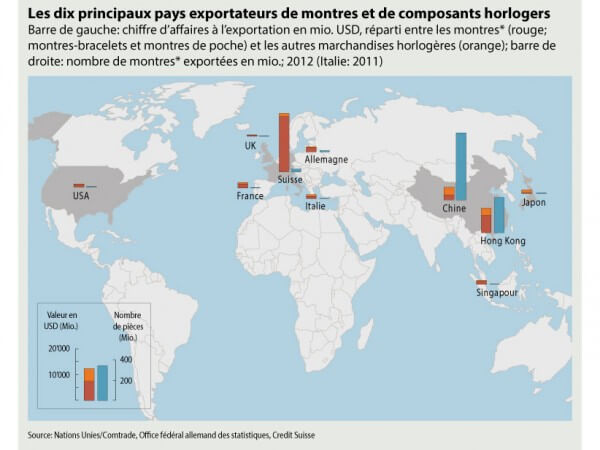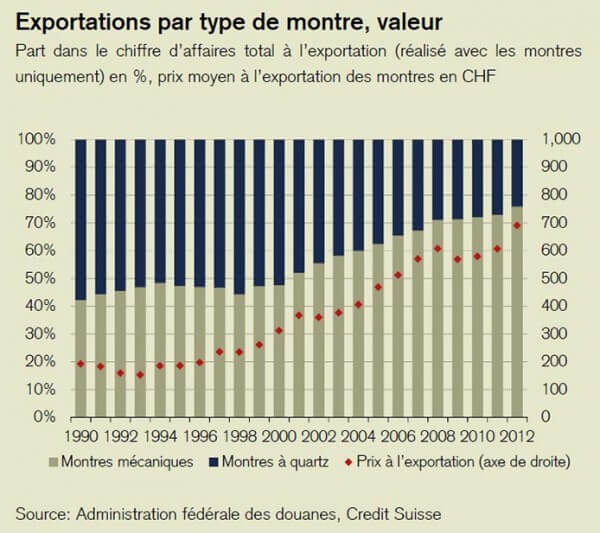Few banks have analysed the watch industry through detailed studies. However, they now seem to want to put the record straight. One after the other, Banque Cantonale Vaudoise (BCV) and Credit Suisse (CS) have published a survey of a sector which, no doubt about it, deserves much closer attention from the banking industry. The first observation regarding CS is that its study, based on various statistical data, provides a good overall picture of the industry. The bank is enthusiastic about the many virtues of the sector: precision, quality, luxury, design, perfect finishing, tradition and high technology, all values epitomised by the Swiss watch industry and that it conveys worldwide through its strong international presence.

It has to be said that the watch industry is an economic driving force for the country. Between 2010 and 2012, it recorded an average growth of exports of 17% per annum, far ahead of other industries. In 2012, the volume of its sales abroad reached a record high of CHF 21.4 billion despite the strength of the Swiss franc and the wave of crises in the euro area. So much so that watch exports now account for nearly 11% of all Swiss goods making their way to international markets. This makes the watch industry the third largest exporter in the country, behind the pharmaceutical industry and machine sector. However, the study overlooks the fact that, shortly, the watchmaking sector should reach second place.

Early exploration of emerging markets
According to Credit Suisse, the undeniable success of the industry, in addition to its position in the luxury world, depends on “an early and intensive exploration of emerging markets.” It is indeed Asia that has by far contributed most to the increase in watch exports in the last decade. “About 70% of recorded growth between 2000 and 2012 can be credited to Asian countries, and Hong Kong and China in particular. In all, these two destinations accounted for about 28% of Swiss watch exports in 2012, against only 14% in 2000,” explains Damian Künzi, one of the authors of the study. No other Swiss economic sector is as export-oriented and has benefited to such a degree from the boom in emerging markets. For about a year now, however, it has seen its growth slow down appreciably, mainly due to the weakening economic climate and political measures dictated in China (see box). This prominence of emerging markets is only just beginning, the bank expects. Vietnam, India, Russia, Ukraine, Malaysia and Mexico are expected to significantly increase their share in Swiss watch exports in the coming years.
In contrast, according to the model developed by the bank, mature European markets such as Italy, Germany and the United Kingdom are expected to lose their importance. It should be noted that not all experts share this point of view and consider incoming tourist flows as significant potential for development in these countries. According to the bank’s study, Brazil, Argentina, South Africa, Thailand and Turkey should also rise in the ranking of the top destinations of “Swiss made” watches. However, most emerging nations start from a very low level. As for the high tariffs levied on Swiss watches, they represent significant barriers to entry. “It is in the Swiss watch industry’s interest to see the conclusion of free trade agreements with these countries,” as was the case recently with China.


Concentration of the sector will continue
Overall, the Credit Suisse economists see a positive outlook for the watch industry in the medium term, without giving specific figures. “In the next few years, we expect continued growth in watch exports, albeit at a slower pace.” According to the bank, the major groups in the sector (Richemont, Swatch Group, LVMH, etc.) as well as traditional independent brands in the upper price bracket are best positioned to capitalise on the expected global demand for luxury goods. Small independent suppliers, however, are suffering from increased pressure due to several structural challenges. The authors of the study point to a continuing concentration process in the sector.
The document also extensively decrypts the disruption caused by the consolidation of the industry. It is an apparent phenomenon that has further accelerated in the past three years. While employment was up 14% between 2009 and 2012, the number of firms fell by 7%. The reason? Vertical integration of the various stages of production. This has resulted in a tougher subcontracting situation with brands that sometimes take over their partners to control their supply chain. All this is largely due to the will of the Swatch Group, announced more than ten years, to stop, in the long term, its deliveries of movements and components to third parties.









